How Does Phonemic Awareness Promote Reading Comprehension
There are many skills a child needs to develop before successfully learning to read and write. Children demand to be aware of how sounds work and how these relate to words before they can fully develop reading and writing skills.
Enjoying a range of books helps to develop children'southward vocabulary, sparks an interest in print, supports comprehension, and develops an enthusiasm to have a become at writing, likewise as helping with their literacy skills. Phonemic awareness is important if a child is to learn these skills.
How Do Children Larn to Recognise and Spell Words?
With an estimated i 1000000 words in the English language, learning to read and spell every discussion by sight would be an impossible task. This is where decoding and encoding become essential – linking the written letter (grapheme) to their sound (phoneme) and recognising how these combine to make words. If children are unable to decode words, and so they will struggle to read fluently and understand what they are reading, and to hear and identify the sounds in words they wish to write.
This highlights the importance of phonemic sensation. Phonemic awareness is the ability to hear and manipulate phonemes (alphabetic character sounds). Children need to become enlightened of how the sounds in words piece of work, and this can then help to develop skills like reading and spelling. In this article, we will outline what phonemic awareness is, how information technology relates to reading and spelling, provide some strategies for didactics and wait at some of the difficulties some children face with phonemic awareness.
What is Phonemic Sensation?
Phonemic sensation is a subset of phonological sensation and involves identifying and manipulating the individual sounds in words.
Phonological sensation develops in the preschool years, and is a good predictor of future reading and spelling abilities. Children need to develop their phonological sensation before they tin acquire to read and spell. Phonological awareness is the procedure of working out the sounds inside speech, and includes picking out rhyming words, recognising alliteration and counting syllables in a word.
The diagram below shows the procedure of phonoligcal sensation:
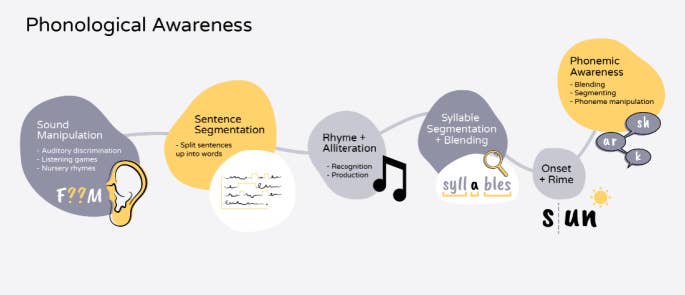
Why is Phonemic Awareness Important?
Recognising that words are made up of discrete sounds, and that those sounds can exist changed, is essential for success in learning to read and spell. Similarly, agreement the connection that words are made upwardly of phonemes and that phonemes are represented by graphemes is a vital skill for understanding impress. Being able to take words apart, put them together again and adapt them into a new word (or even a nonsense give-and-take!) is a cardinal skill.
There would not be much benefit to teaching children new grapheme phoneme correspondences (GPCs) without some awareness of how they combine to make a word. Reading with a child would involve listening to them string out individual messages, without whatever meaning, and writing with a child would end up with them having to exist told which letters they need to write. This would exist a stressful and frustrating situation for all.
There is, of course, a fourth dimension and a identify for learning words by rote, for case 'tricky words' or 'common exception words', but the strategies for learning these would not be constructive for learning to read and spell every unmarried word.
How Does Phonemic Awareness Chronicle to Reading and Spelling?
The Simple View of Reading (Gough and Tunmer, 1986) is a useful model demonstrating how word recognition and comprehension are essential for learning to read.
Acquisition of these two abilities requires the evolution of more specific skills:
- Phonemic sensation: the ability to place and manipulate the singled-out individual sounds in spoken words.
- Phonics: the ability to decode words using knowledge of letter of the alphabet-sound relationships.
- Fluency: reading with speed and accurateness. Existence able to read automatically, accurately and chop-chop is an important skill when learning to read.
- Vocabulary: knowing the pregnant of a wide multifariousness of words and the structure of written linguistic communication.
- Comprehension: agreement the significant and intent of the text.
A child who struggles with one of these interrelated skills, such equally phonemic awareness, is likely to have a poor reading power.

At that place are six dissimilar types of phoneme sensation skills. The first three normally develop offset with the final 3 taking a piffling longer to principal:
- Isolating phonemes: what is the first/ last sound in 'true cat'? (c/t)
- Blending phonemes: alloy the phonemes together to brand a word, for example "r-u-g" (carpeting)
- Segmenting phonemes: carve up the phonemes in a word, for case mop (m-o-p)
- Deleting phonemes: say "snail" now say it without the 'due north' (sail)
- Adding phonemes: say "lap" now put a 'c' at the beginning (clap)
- Substituting phonemes: change the 'c' in cat to 'b' (bat)
Oral blending and oral segmenting are the main aspects of phonemic awareness and are very important skills to develop when learning to read and spell.
Oral Blending focuses on the sounds we hear, rather than the words we see. It is when you lot alloy phonemes together to make a discussion, and is a forerunner for blending to read words. For oral blending you demand to push the letters together to say the word, for example:
- "Can you notice the h-a-t?" and yous find the hat.
- "Can you touch your "ch-i-northward?" and you bear on your chin.
Oral Segmenting focuses on the sounds nosotros hear, rather than the words nosotros see. It is when yous dissever the phonemes from a give-and-take, remembering the lodge in which they occur. Information technology is a forerunner for segmenting to spell words. For this you need to stretch the discussion out to hear the sounds, for example:
- "What sounds can y'all hear in the word box?" and the answer is "b-o-x".
- "What sound can you hear in the word volume?" and the answer is "b-oo-thousand".
Strategies for Pedagogy Phonemic Sensation
Some children will develop the phonemic awareness incidentally, picking it upwards through phonological and other listening games and activities, while others may demand it to be taught explicitly.
Often children find the concept of orally blending and orally segmenting more meaningful and interesting if the action involves a puppet, similar an conflicting or a robot, and to communicate with it you lot need to use 'audio talk' or 'robot talk'.
Things to remember when education phonemic sensation are:
- It is important for children to hear lots of modelling of these skills, before beingness asked to do information technology themselves.
- Most children learn to orally blend words before they tin orally segment, and when learning to segment, they may not hear and say all the phonemes in a discussion. For example, for the word cup, they may say "c-p".
- Ideally, they should grasp the concept of phonemic awareness, or at least show some understanding of it, before learning grapheme-phoneme correspondences (GPCs).
- Continually working on phonemic sensation and other phonological activities aslope teaching phonics is of import.
- Stick to cvc words (consonant vowel consonant) at first, but remember that these don't but include words similar hat and van, but besides words like sheep (sh-ee-p) and chick (ch-i-ck).
- Activities should be enjoyable and engaging; children should want to practise the activity once again. Remember, creating a positive attitude towards reading and writing is essential to build on these skills.
- Phonemic sensation can be adult without whatever written word. Making activities multi-sensory and practical is of import, especially with younger children or those with Send.

Games and Activities to Support Phonemic Sensation
Games and activities tin be useful for supporting phonemic awareness. For these activities, showtime off with blending the phonemes to say the word. As the child's skills for this amend, they can have a go at segmenting the words for others to blend and to conduct out the didactics.
Some games and activities y'all tin effort include:
- I Spy: look for items in the classroom, on a poster or on a jigsaw as a prop. Then, instead of using just the initial phoneme, segment the whole word. For example, say "I spy with my footling eye a h-or-se" and then let the kid find a flick of a horse.
- Can you affect your…: inquire the kid to touch various parts of their body, for example their "h-ea-d", "ch-ee-k", "ch-i-n" and "50-eastward-chiliad".
- Classroom instructions: ask the child "Can you observe your ch-air?" and "Can you find your c-oa-t?".
- Tap your shoulder if you hear…: children tap their shoulder if they can hear a certain sound. For example "Tap your shoulder if you tin hear an 'a' sound in these words – hand, apple, ant, dog".
- Audio jump: say a word and then leap forward for each phoneme in a word.
As children's ability to orally blend and segment improves, you should begin to model with words. Hither are some examples of activities where the child blends and segments the words:
Sound buttons and phoneme frames: split words up into their phonemes and sound buttons.
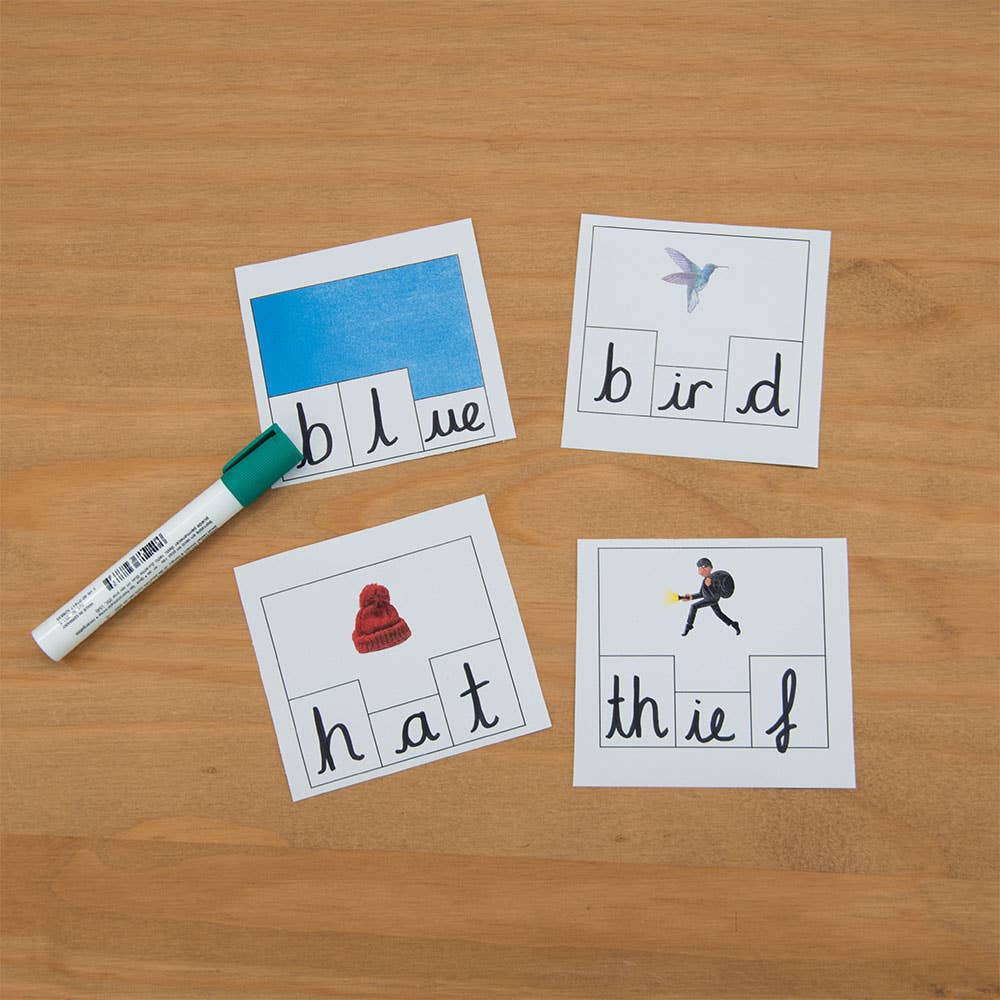
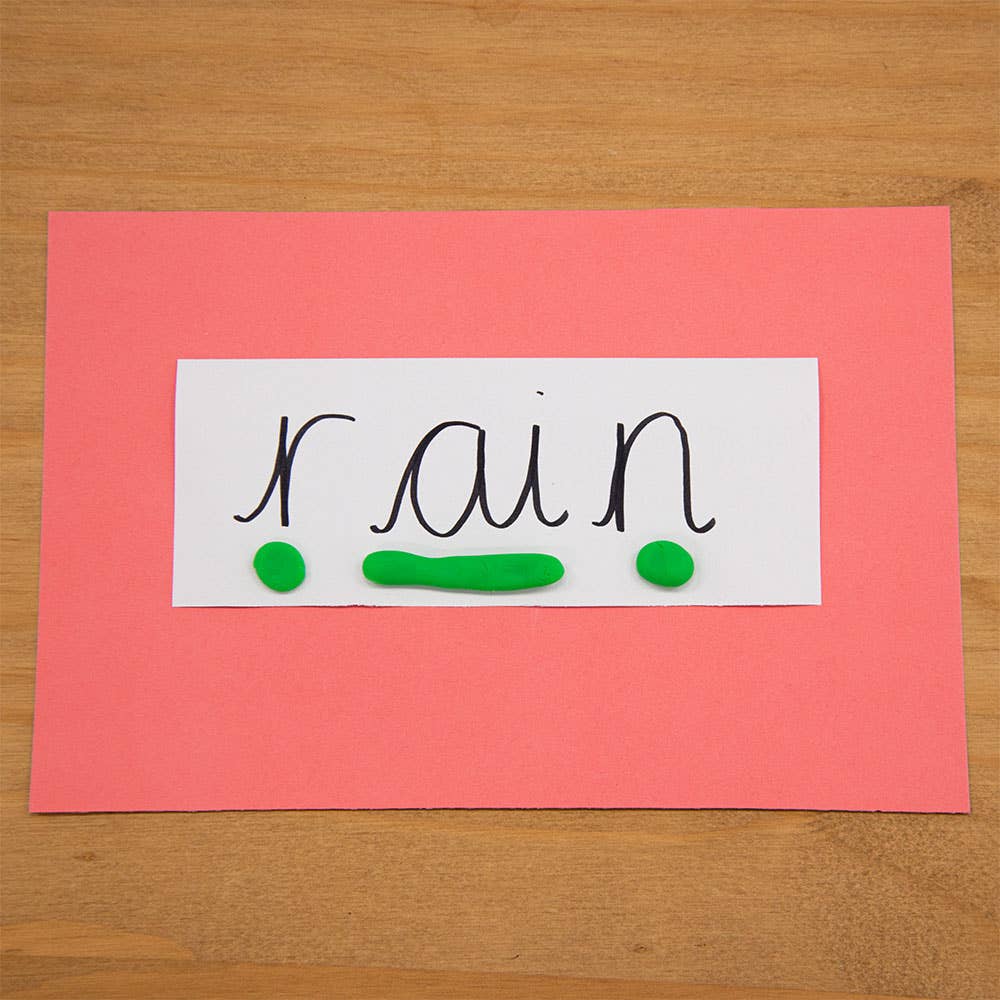
Full circle: modify one letter at a time to make a new word each time, until you have gone full circumvolve. For example, using the letters southward,a,t,p,i and making sabbatum, sit, sip, tip, tap, sap, sabbatum.
Washing line: peg out messages in the wrong order for children to rearrange.
If a Child is Struggling with Phonemic Awareness
If a child you are working with seems to be struggling with phonemic awareness, they may not exist developmentally ready yet. If this is the instance, it is worth spending some time focussing on listening games, and other phonological games and activities.
Listening games include:
- Using instruments to keep a beat and compare the pitch and tone.
- Environmental audio walks: going for a walk and listening to sounds in the environment.
- Body percussion and voice sounds: for example, brand your vocalism sound like: a ball – "boing boing"; going downwards a slide – "wheeee"; and a train – "chchchch choo choo!"
Other phonological awareness activities include:
- Word awareness: count the words in a judgement, or clap or stamp each word in a sentence, for example in "A frog on a log".
- Alliteration: identifying, and later producing, words that begin with the same audio, and making lightheaded sentences similar "an angry alligator ate all Abby's apple!".
- Rhyming: identifying, and later producing, words which have the same endings. For example, looking at pictures of a cat, bat, lid and domestic dog and finding the words which rhyme.
- Syllable Awareness: clapping or borer parts of a word into syllables, such as children's names. For example, 'A-lex-an-der' would take four claps.
There are many more examples of listening games available in Stage i Letters and Sounds Guidance, as produced by the Department for Education.

Factors that tin can Affect a Child'southward Phonemic Awareness
There are a number of factors that tin bear on a kid'due south phonemic awareness. Firstly, check that the child is pronouncing the phonemes correctly. At that place is a tendency for people to put an 'uh' sound on some phonemes, for case, "cuh" rather than "c" and "duh" rather than "d". This leads to a struggle to alloy phonemes: for instance with the word true cat, instead of blending "c-a-t", they may attempt "cuh-ahh-tuh", making "cuhahhtuh", which tin can cause confusion equally it'south non a word.
Other factors which can touch on a child's phonemic awareness include:
Hearing difficulties: near children have a hearing exam in their beginning year of schoolhouse, though temporary hearing loss following a common cold and glue ear are mutual. Hearing tests can be organised at any time by speaking to the child'southward GP, schoolhouse nurse or health company. At that place'due south more information on hearing tests for children on the NHS website.
Speech and language difficulties: a child may have difficulty pronouncing sounds and words correctly. If this is the case they may need a Speech and Linguistic communication Therapy assessment, which again can be organised through the kid's GP, School Nurse or Wellness Visitor. At that place's more information on spoken language and language assessments on the ICAN website.
Dyslexia: dyslexia is a learning difficulty which primarily affects accurate and fluent reading and spelling. One the characteristics of dyslexia is poor phonological sensation, and children with dyslexia will frequently need actress support.
Autism: some children with autism have speech audio difficulties or auditory processing disorders. Many children with autism are visual thinkers, and find abstruse concepts similar oral blending and segmenting hard to grasp. They are more likely to benefit from using concrete objects, similar magnetic letters. Remember to avoid long exact explanations.
Working memory: working memory is the power to concur and manipulate information in the mind for a curt menstruum of time. There is evidence to suggest that verbal working retentivity tin can affect performance of phonological sensation tasks and activities which involve following and recalling instructions, rote learning, singing songs, retelling stories and copying sound patterns. Working memory co-exists with dyslexia, dyspraxia and ADHD, simply can besides be a stand alone problem.
If you doubtable a kid y'all are working with does have difficulties, you should follow the guidance from the Send Code of Do (2015) – The Graduated Approach, of Assess, Plan, Practice, Review.
Further Resource
- The Importance of Routine for Children: Free Weekly Planner
- Why is Reading and so Important for Children?
- Education Training Courses
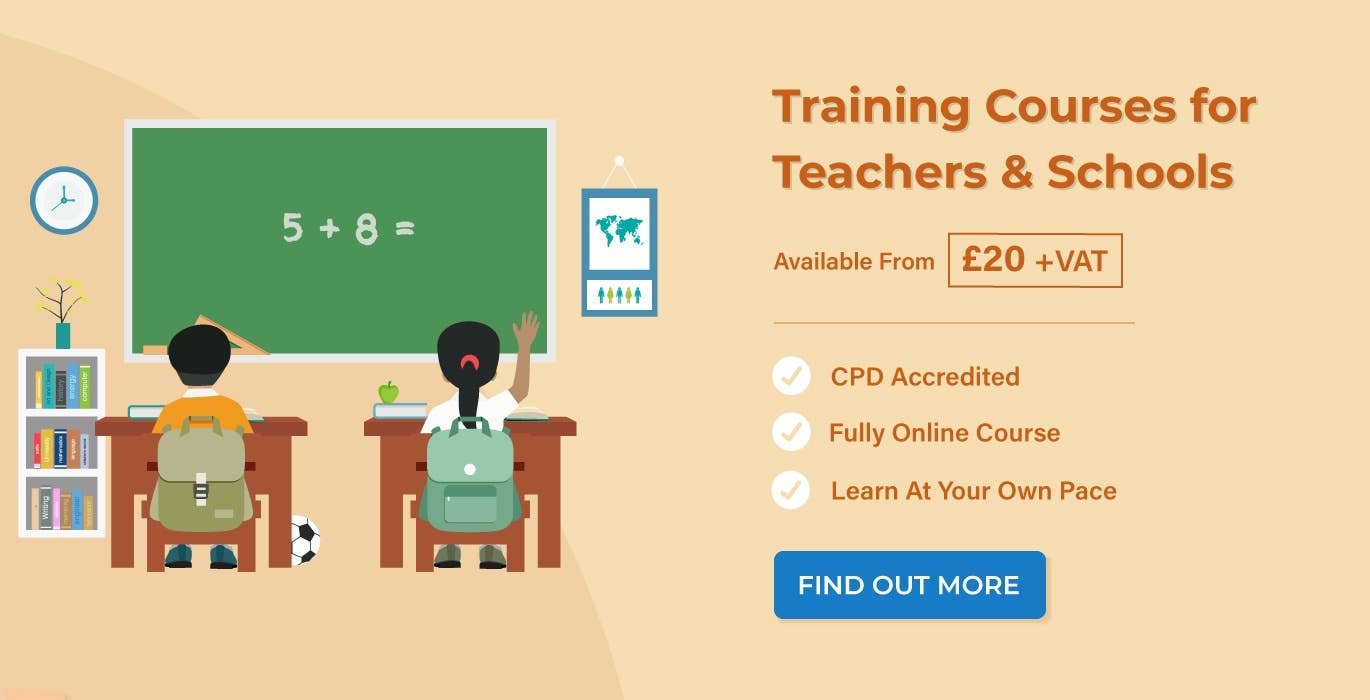
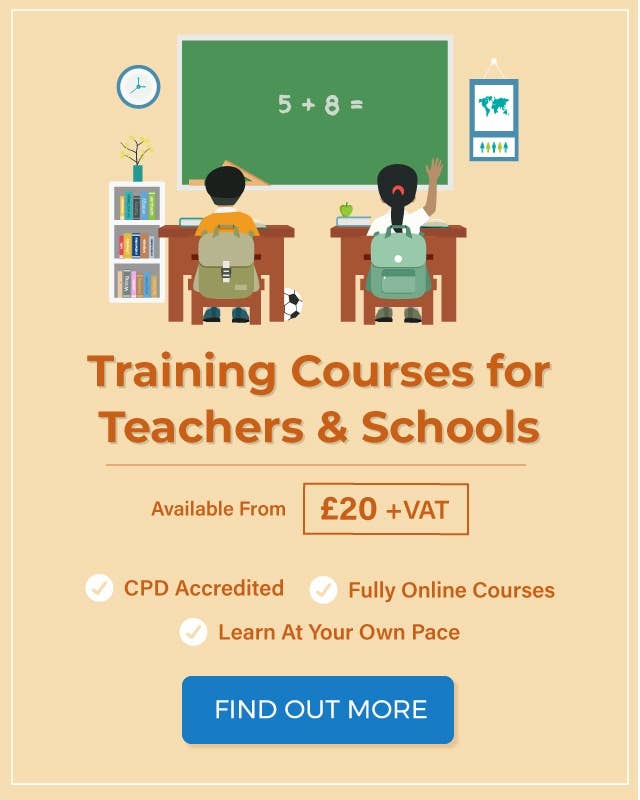
Source: https://www.highspeedtraining.co.uk/hub/phonemic-awareness-teaching-strategies/
0 Response to "How Does Phonemic Awareness Promote Reading Comprehension"
Post a Comment